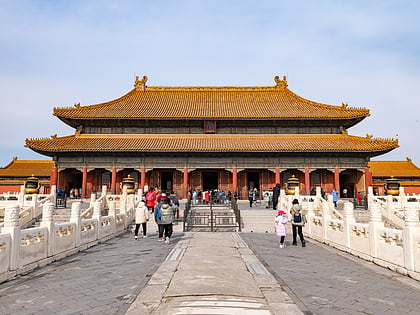Hall of Supreme Harmony, Beijing

Facts and practical information
The Hall of Supreme Harmony, also known as the Throne Hall, is the heart of the Forbidden City and stands as an iconic emblem of Beijing's imperial past. Constructed during the Ming Dynasty in the 15th century and later rebuilt in the 17th century after a fire, it is the largest wooden structure in China, exemplifying the pinnacle of traditional Chinese architectural achievement.
As the ceremonial center of Chinese power for nearly five centuries, the Hall of Supreme Harmony was the site of major state events, such as the emperor's enthronement, the Lunar New Year, and the Winter Solstice. Emperors of the Ming and Qing dynasties also used this grand hall to receive high officials and foreign envoys.
The hall's design is rich in symbolism, reflecting the might and grandeur of the emperor. It is elevated on a three-tier marble terrace, signifying its importance and the hierarchical nature of the Chinese universe. The roof is adorned with intricate golden tiles, and the building is flanked by meticulously carved dragon motifs, which represent imperial power.
Visitors to the Forbidden City are often struck by the sheer scale of the Hall of Supreme Harmony. It towers over the surrounding squares and courtyards, offering an impressive view that captures the essence of imperial authority and architectural splendor. Inside the hall, the throne and its surrounding artifacts are well-preserved, providing a glimpse into the opulence of the Chinese court.
Hall of Supreme Harmony – popular in the area (distance from the attraction)
Nearby attractions include: Forbidden City, Wangfujing, Jingshan Park, Palace of Heavenly Purity.
Frequently Asked Questions (FAQ)
Which popular attractions are close to Hall of Supreme Harmony?
How to get to Hall of Supreme Harmony by public transport?
Bus
- 西华门 • Lines: 5 (9 min walk)
- 北海南站 • Lines: 5 (10 min walk)
Metro
- Tian'anmen East • Lines: 1 (18 min walk)
- Jinyu Hutong • Lines: 8 (19 min walk)








 Subway
Subway









